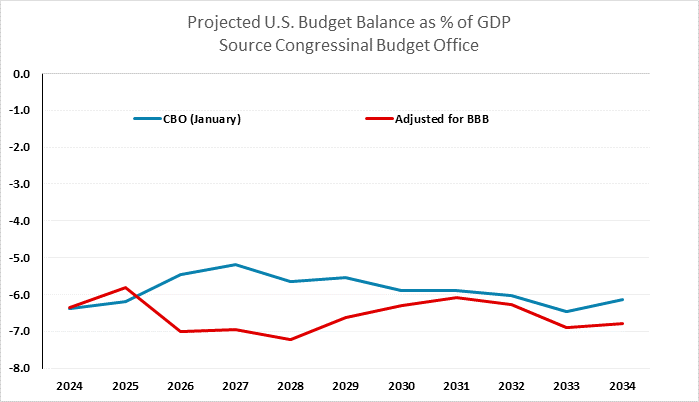Big Beautiful Bill will bring larger US budget deficits
The “Big Beautiful Bill” on fiscal policy passed by the House was costed by the Congressional Budget Office on May 20 and shows a significant boost to the budget deficit in the remainder of the current Trump presidential term. This is because tax cuts have been front loaded and spending cuts back loaded. There is significant risk that the tax cuts may last for longer and the spending cuts fail to materialize.
The bill makes the 2017 tax cuts, which largely benefit corporations, permanent, but adds other tax cuts that will benefit individuals, and these expire at the end of 2028. These include ending taxes on tips and overtime, reduced taxes on car loans, an increased child credit and a deduction for seniors designed to have a similar impact to Trump’s campaign pledge not to tax social security. It is likely to be difficult to reverse these measures in 2029.
The largest, and most controversial of the spending cuts come in Medicaid, which provides health insurance to those on low incomes, and these do not appear until the end of 2026, after the midterm elections. It was originally intended to delay the cuts to 2028, but they were brought forward to 2026 to offset a higher SALT deduction, which allows state property taxes to be offset, something some Republicans in Democratic states insisted on. It is uncertain whether the Medicaid cuts will ever be implemented, particularly if the Democrats gain control of Congress in 2026.

While the 2025 budget deficit will be reduced, largely on cuts in education, we are going to see significant increases in the deficits in 2026, 2027 and 2028, of around 1.5% of GDP, with those years now set to see deficits of around 7.0% of GDP when the CBO’s January deficit forecasts are adjusted for. Even these forecasts may be too low given that they do not take into account the impact on interest. January’s CBO forecasts assumed rates of around 3.5%. However the forecasts do not assume enhanced tariff revenues. Trump’s revived enthusiasm for tariffs today (on Apple and the EU) may be in part related to a desire for revenues. Still, even aggressive tariffs will not be able to eliminate the lift to the deficit.
The deficit may narrow in the next presidential term if various tax cuts expire as scheduled and Medicaid sees the cuts that are planned, but this appears unlikely. Even under the assumptions of the “Big Beautiful Bill”, the deficit would return to near 7.0% of GDP by 2025. When recently downgrading US debt, Moody’s suggested that the deficit could reach 9.0% of GDP by 2035. The bill, which cleared the House by a solitary vote, still needs Senate approval. That is far from assured.